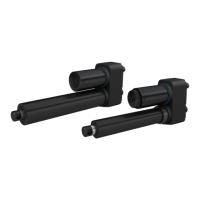34
CAHB-20 series
10.0
Malfunctions
The following chapter describes potential causes for mal-
functions and the work that is necessary to restore
operation.
Intheeventoffrequentmalfunctions,shortenthemainte-
nance intervals.
Contact the manufacturer concerning malfunctions which
are not solved by the following suggestions.
Personnel
• Unlessindicatedotherwise,theworkdescribedhereinto
solve malfunctions may be performed by the operator.
• Someworkmayonlybecarriedoutbyqualiedpersonnel,
whichisspecicallyindicatedinthedescriptionoftheindi-
vidual malfunction.
• Work on the electric system may only be performed by
professional electricians.
DANGER
Electrical shock and moving parts hazards
Serious injury or death can be caused by touching live electrical
components and by unexpected movement of the actuator.
Be sure power supply is off and actuator is locked out before
installing.
DANGER
Danger if restarted without authorization!
Whencorrectingfaults,thereisdangeroftheenergysupplybeing
switched on without authorization. This poses a lifethreatening
hazard for persons in the danger zone.
Therefore:
• Priortostartingwork,switchothesystemandsafeguarditfrom
being switched on again.
DANGER
Risk of injury and material damage due to incorrect repair of
malfunction
Therefore:
• Never loosen the screws on the linear actuator or try to openthe
linear actuator.
• Intheeventofamalfunctionthatcannotbexedbyfollowing
Malfunction table (⮑page35),thendismantletheactuatorand
send it to the manufacturer for repair (⮑5.0Transport,packag-
ing and storage, page 21)
Behavior during malfunctions
In principle:
1. In the event of a malfunction that may present an imme-
diatedangertopersonsorassets,turnotheactuatoror
control unit immediately and safeguard against a restart.
2. Determine cause of malfunction.
3. Dependingonthetypeofamalfunction,haveitrepaired
byqualiedpersonnel.
4. Inform responsible party on-site concerning malfunction.
NOTE
The following malfunction table provides information as
to who is authorized to perform the repair.

